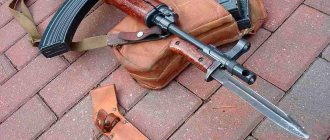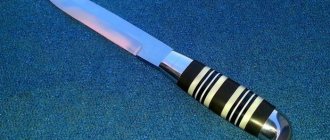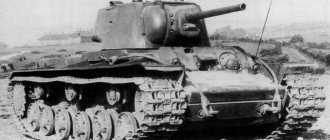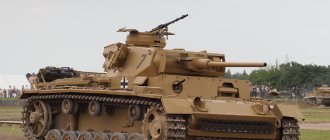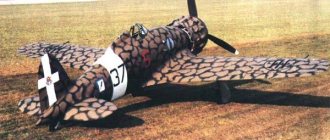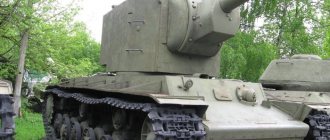Higher and higher
By 1933, having designed a very successful 88-mm anti-aircraft gun “8.8-cm Flak 18” (Acht-comma-acht Zentimeter - 8.8 cm), colloquially called “acht-acht” (see NIT No. 1 and No. 2 for 2012), the Germans did not rest on this, but continued to work on even more powerful anti-aircraft guns. In addition to his love for “big guns” and Hitler’s opinion that anti-aircraft guns were precisely the means that would prevent enemy aircraft from entering the skies of Germany (anti-aircraft guns, throwing their deadly cargo into the skies, were supposed to help preserve and even increase the morale of the population), this was also explained for quite prosaic reasons. The fact is that the newly designed bombers climbed, as the song sang, “higher and higher.” And if in the early 30s the effective fire altitude of the Flak 18 anti-aircraft gun, amounting to 7.6 thousand meters, was more than enough to drive any existing enemy bomber into the ground, then since 1936 a medium bomber appeared in the British arsenal “ Wellington", with a maximum flight altitude of more than 7.1 thousand meters, which has already become difficult for the "aht-ahtam" to reach. Subsequently, this trend only intensified. During the bombing of German cities, Allied planes tried to fly as high as possible. So in May 1944, the command of the 1st Air Defense Division of Berlin reported to the leadership: “With the current raid altitude of 7-8 thousand meters, the 8.8 cm Flak 36/37 anti-aircraft guns have exhausted the limits of their reach.” Later, crushing raids by Allied aircraft, bombing cities and industrial facilities of the Reich, were carried out at altitudes of about 10 thousand meters. Accordingly, more powerful anti-aircraft guns were required, with a higher altitude for effective fire. And the Germans had them...
10.5 cm anti-aircraft gun on a Sonderanhanger 201 trailer in stowed position
Multiple launch rocket systems
Since the Great Patriotic War, multiple launch rocket systems (MLRS) have been a distinctive calling card of Soviet and then Russian artillery. In the second half of the 1950s. In the USSR, the 122-mm 40-barrel BM-21 “Grad” system was created, which is still in service with the armies of more than 30 countries. At the beginning of 1994, the Ground Forces of the Russian Federation had 4,500 such systems.
BM-21 "Grad" became the prototype of the "Grad-1" system, created in 1975-1976. to equip tank and motorized rifle regiments, as well as the more powerful 220-mm Hurricane system for army artillery units. This line of development was continued by the long-range Smerch system with 300-mm rockets and the new Prima divisional MLRS with an increased number of guides and increased-power rockets with a detachable warhead.
In the future, it is planned to re-equip the Russian rocket artillery with combat vehicles of the Tornado family. The following MLRS of this family are currently being tested:
• "Tornado-G" caliber 122 mm; • "Tornado-S" caliber 300 mm.
These MLRS have a modernized chassis, new missiles with a longer flight range, as well as an automated guidance and fire control system (ASUNO).
Flak 38 and Flak 39
Back in 1933, when the first Flak 18 anti-aircraft guns were just starting to roll off assembly lines, the military ordered Rheinmetall Borsig to design a 105 mm anti-aircraft gun. Moreover, this weapon had to be “registered” not only on land, but also at sea - providing air defense for large ships of the nascent Kriegsmarine (Navy). By 1935, each company presented two prototypes of its 105-mm anti-aircraft guns, which passed comparative tests that same year. According to their results, the 105-mm gun () was recognized as the best. At the end of 1937, the final version of this weapon was put into service under the name 10.5-cm Flak 38 (10.5 Flugabwehrkanone 38). By the beginning of World War II, only 64 guns had been built.
10.5 cm Flak 38 in firing position, installed in position
In 1939, the 10.5-cm Flak 38 cannon was modernized, and from 1940, the Flak 39 began to enter the army, differing from the Flak 38 anti-aircraft gun in the design of the barrel, carriage and the type of electric motors of the guidance system. The 10.5 cm Flak 39 barrel was made as a composite barrel. The fact is that anti-aircraft guns, as weapons with high internal ballistics, had a high initial projectile velocity (the speed of the projectile when exiting the barrel), which for the 10.5-cm Flak 38 reached 860-880 m/sec. The high initial speed and, accordingly, the significant weight of the powder charge led to rapid “heating” (wear) of the barrel. With a worn barrel, the firing accuracy and height of effective anti-aircraft fire dropped sharply, but replacing it was very difficult and not cheap. Therefore, a design for prefabricated barrels was developed, which made it possible to replace not the entire barrel, but only its individual, most worn-out elements. The Flak 39 received such a barrel. The barrel had a free tube, consisting of three parts: chamber, middle and muzzle. The chamber and middle parts were connected at the front end of the chamber, and the joint between them was blocked by a sleeve. The middle and muzzle parts of the pipe were connected in the rifled part of the channel, and the joint between them did not overlap. The parts of the free pipe were collected in a shell or prefabricated pipe and tightened with nuts. The advantage of the composite pipe was the ability to replace only the middle part, which was most susceptible to “heating.”
10.5 cm Flak 38 in one of the museums
Both Flak 38 and 39 anti-aircraft guns had guidance, feeding and fuse installation mechanisms driven by electric motors. But if the Flak 38 had electro-hydraulic direct current guidance drives (the same as those of the 8.8-cm Flak 18 and 36), then on the Flak 39 they were replaced by the UTG 37 system on alternating current at industrial frequency, which had already been tested and tested on 8.8-cm Flak 37.
The Flak 38 four-gun battery was equipped with a special installation with a gasoline engine that drove a 220 V DC generator with a power of 24 kW. The generator supplied power to the electric motors mounted on the guns. Each gun had four electric motors: vertical guidance, horizontal guidance, rammer and automatic fuse installer. In the Flak 39 guns, the electric motors were converted to alternating current in order to be able to connect to industrial and municipal power grids.
The 10.5 cm Flak 39 had a semi-automatic wedge bolt with a self-cocking mechanism and an electric trigger, which allowed it to fire 12-15 rounds per minute. The semi-automatic was of a mechanical type and was cocked when rolling up. During the recoil of the barrel after firing, the bolt automatically opened, ejecting the spent cartridge case, and the spring of the bolt locking mechanism was cocked. If necessary, the shutter could be opened or closed manually. To load the projectile for the first time, the bolt had to be opened manually. The safety device allowed a shot to be fired only when the bolt was completely closed.
The recoil devices consisted of a spindle-type hydraulic recoil brake and a hydropneumatic knurler. The spring-type balancing mechanism was located under the barrel - spring compensators were mounted in two cylinders to facilitate vertical aiming of the gun.
To transport the 105-mm anti-aircraft gun, it was mounted on two wheel drives/trolleys of the Sonderanhanger 201 transporter (similar to the 88-mm Flak 18/36/37), which were disconnected when the gun was transferred from the traveling position to the combat position. From the ground, the guns fired from a cross-shaped carriage, which made it possible to conduct all-round fire with an elevation angle of up to 85 degrees. In addition, 10.5 cm Flak 39 were installed on railway platforms and on special pedestals for stationary positions.
The standard gun crew consisted of a squad commander and 9 servants, plus 2 more people when loading the gun manually.
Anti-aircraft gun 10.5 cm/65 SK C/33
For the 10.5 cm Flak 38/39, 3 types of projectiles were developed - high-explosive fragmentation with different types of fuses and two armor-piercing. The effective fire height of the gun was 9.3 thousand m (with an initial projectile speed of 880 m/s), and the ballistic ceiling of the projectile was 1.2 thousand m. The armor penetration of an armor-piercing projectile at a distance of 1 thousand m was 138 mm, with an initial speed of 860 m/s.
It is interesting that at the height of Soviet-German economic cooperation, when the Third Reich was in dire need of raw materials, and the Soviet Union in modern equipment and technologies, four 105-mm Flak 38 anti-aircraft guns were purchased from Germany. In Soviet documentation they were designated GOD (German special delivery). The anti-aircraft guns were delivered to the USSR and tested in the fall of 1940 at the anti-aircraft research site near Yevpatoria. The Flak 38 was tested in conjunction with the Soviet 100 mm L-6 and 73-K anti-aircraft guns. The ballistics of Soviet guns and Flak 38 were almost the same, but the accuracy of Flak 38 shells was twice as high. In addition, the German shell produced 700 lethal fragments, while the Soviet shell, with the same mass, produced only 300. The very precise work of the automatic fuse installer was noted. The survivability of the barrel is determined to be 1000 shots (with a drop in initial speed of 10%). Nevertheless, for some reason, perhaps in order to avoid accusations of “admiration of Western technology” (there was such an article in the criminal code), it was recommended to adopt not the German Flak 38, but a completely “raw” one, but “our own” 100-mm anti-aircraft gun 73-K. By the way, they never managed to bring it to mind.
In Germany, the 10.5 cm Flak 38 and 39 remained in production throughout the war. In August 1944, the Luftwaffe had: 116 Flak 38 and 39 in railway installations; 877 i on stationary installations; 1025 and on conveyors like Sd.Ah.201 (Sonderanhanger 201). In addition, the 10.5-cm/65 SK C/33 double-barreled anti-aircraft turret was developed for the Kriegsmarine, which was supposed to provide air defense for large warships. Such towers were installed on the pocket battleships “Deutschland”, “Scharnhorst”, “Bismarck”, on the heavy cruisers “Admiral Hipper”, “Prinz Eugen”, and they were also supposed to equip the first German aircraft carrier “Graf Zeppelin”. The installation weighed about 27 tons and had a rate of fire of 15-18 rounds/min. To compensate for the ship's pitching motion, there was an electromechanical stabilizer, but it did not work satisfactorily on the open sea.
| Production of Flak 38 and 39 during the war | ||||||
| 1939 | 1940 | 1941 | 1942 | 1943 | 1944 | 1945 |
| 38 | 290 | 509 | 701 | 1220 | 1131 | 92 |
Performance characteristics of Flak 38 and 39:
| Caliber, mm | 105 |
| Barrel length, mm | 6648 |
| System weight in combat/stowed position, kg | 10240/14600 |
| Vertical aiming angle, degrees. | from -3 to +85 |
| Horizontal aiming angle, degrees. | 360 |
| Rate of fire, rds/min | 15-20 |
After the war, a number of 8.8 cm and 10.5 cm German anti-aircraft guns were also in service with the Soviet Army. One of these weapons was on display at the Museum of the Armed Forces in Moscow. According to American sources, several dozen 8.8 cm and 10.5 cm German guns also took part in the Korean War.
Missile weapons
The first tactical missile weapon systems appeared in the USSR ground forces in the late 1950s and early 1960s. These were the Mars, Filin, Luna and Luna-M complexes with unguided solid fuel rockets. The relatively low accuracy of these missiles made it possible to hit enemy targets only when using a nuclear warhead. This was the reason for the abandonment of unguided rockets and the transition to the creation of guided ones.
The Tochka complex, adopted for service in 1976, was the first complex with a missile controlled along its entire trajectory. In 1989, the Tochka-U complex with a launch range increased to 120 km entered service. Compared to the Tochka complex, its accuracy is increased by 1.4 times. Until now, this complex has been the main one in the Ground Forces of the Armed Forces of the Russian Federation.
In 2006, the Russian Army adopted the new Iskander operational-tactical missile system. At the end of 2007, the first division of these missile systems was formed, and in the future they will staff five missile brigades. The Iskander complex has great modernization potential, including increasing the firing range.
When a political decision is made on Russia's withdrawal from the INF Treaty, its range can be increased to 500 kilometers or more. In this case, it will become one of the options for an asymmetric response to the deployment of the American missile defense system in Eastern Europe.
Flak 40
Having developed a 105-mm anti-aircraft gun, the “gloomy German genius” did not stop there. The apotheosis of his efforts and the most powerful anti-aircraft gun used during World War II was the 128 mm anti-aircraft gun. Although it was not produced in mass quantities, it undoubtedly became the most effective heavy anti-aircraft gun of its time.
128-mm Flak 40 anti-aircraft gun in combat position
The idea of acquiring 128-mm anti-aircraft guns first arose among the military in 1936, and it was ordered to prepare a corresponding project, which received the internal index “Gerat 40”. Since the priority of this development was not very high, the work proceeded slowly and the final version of the prototype was ready only by 1940. Nevertheless, back in December 1938, the company was given a preliminary order for 100 anti-aircraft guns.
It was initially assumed that the Gerat 40 would be adopted by field army units, so a certain mobility was required from this installation. However, there were problems with this. The installation was so heavy - its weight in the combat position was 12 tons - that transporting it as before (on a two-axle wheeled transporter of the Sonderanhanger 201 type without disassembling) was possible only over very short distances. Therefore, it was proposed to remove the barrel and transport it on a separate trailer. But trial operation of the prototype showed that such disassembly was impractical - the installation still remained too cumbersome. As a result, a four-axle Sonderanhanger 220 transporter was developed to transport unassembled guns.
However, when the military fully realized the size and weight of the prototype presented to them, it was decided that this weapon would only be built in a stationary version. Those. the gun was installed in position on a concrete base and was not equipped with its own conveyor. The anti-aircraft gun was named 12.8-st Flak 40, and its production was given the green light. However, by that time the assembly line had already been prepared for the production of a mobile version of the 12.8-speed Flak 40, so the first six units were still built in a mobile version. They formed the only mobile battery that entered the army at the end of 1941.
Due to its large weight (12 tons), it was initially planned to transport the 12.8-cm Flak 40 in a disassembled state - the barrel was removed and transported on a separate trailer
The restructuring of production took time, and as a result, production of the stationary version of the Flak 40 began only in 1942. Taking into account the fact that the installation was very complex and expensive, by August 1944 there were only 449 Flak 40s in German service, of which 242 were stationary installations, 201 railway installations (on railway platforms) and 6 mobile installations. The placement of a relatively large number of Flak 40 guns on railway platforms is explained by the desire to ensure the mobility of air defense forces and the ability to transfer heavy anti-aircraft batteries to protect various objects. The number of Flak 40s reached its maximum in January 1945, when there were 570 units in service. They were used exclusively to protect the most important industrial facilities on the territory of the Third Reich, as well as such major cities as Berlin, Vienna, Hamburg; here, for their best use, even special anti-aircraft towers (Flaktuerme) were built.
The 12.8-st Flak 40 anti-aircraft gun had mechanisms for guidance, supply and delivery of ammunition, as well as fuse installations driven by electric motors powered by 115 V alternating current. Therefore, the four-gun battery had to be served by one 60 kW generator. The design of the carriage and the guidance mechanisms made it possible to give the barrel a maximum elevation angle of 87 degrees, and all-round firing was ensured in the horizontal plane.
Trial operation of the 12-cm Flak 40 prototype showed that disassembling the gun during transportation was impractical - the installation was still too cumbersome. As a result, a four-axle Sonderanhanger 220 transporter was developed to transport unassembled guns. 12.8-cm Flak 40 in the factory yard
The fire control of the 12.8-st Flak 40 battery was carried out using the Kommando-Gerät 40 - a fire control device with a four-meter optical rangefinder. Using the rangefinder, the following were determined: the range to the target, flight altitude and angular coordinates - azimuth and elevation - of the target. Based on them, firing data was generated, which was transmitted via cable to the guns.
Firing from the 12.8-st Flak 40 was carried out in unitary shots with fragmentation shells weighing 26 kg, which had an initial speed of 880 m/sec. The powder charge of a 128 mm shot was four times greater than that of an 88 mm shot. Technically, the gun provided a height reach of 14.8 thousand m, but the remote fuse allowed firing only up to 12.8 thousand m. To increase the effective firing ceiling of 105 mm and 128 mm anti-aircraft guns, fragmentation active rocket projectiles were developed. The muzzle velocity of such a 105-mm projectile was 800 m/s, and then the jet engine accelerated it to 1150 m/s. However, the end of the war did not allow the launch of active-missile projectiles into mass production. Similar active-missile projectiles were created for the 128-mm Flak 40 anti-aircraft gun. But here, too, everything was limited to the release of a pilot batch. Speaking about technical innovations in the design of anti-aircraft shells, we should also mention attempts to create high-frequency radio fuses for them, the action of which is based on the Doppler effect. For example, radio fuses were studied in Vienna (Kakadu fuse) and Blauppunkt-Veerke in Berlin (Trichter fuse). The value of such fuses was that they ensured non-contact detonation of the projectile when the distance between it and the target was minimal.
In addition to anti-aircraft shells, the Flak 40 could also fire armor-piercing shells of the 1940 and 1943 models, which penetrated armor 127 and 157 mm thick, respectively, at a distance of 1.5 thousand m. However, these shells were mainly used in the Jagdtiger tank destroyers.
Flak 40 mounted on one of the Berlin anti-aircraft towers
Barrel field artillery
The Russian army has a huge number of cannon artillery pieces. They are in service with artillery units, units and formations of the ground forces and represent the basis of the firepower of marine units and internal troops. Barrel artillery combines high firepower, accuracy and accuracy of fire with simplicity of design and use, increased reliability, mobility and flexibility of fire, and is also economical.
Many samples of towed cannon artillery guns were designed taking into account the experience of the Great Patriotic War of 1941-1945. in the Russian army they are gradually being replaced by those developed in 1971-1975. self-propelled artillery pieces optimized for performing fire missions in conditions of the use of nuclear weapons. Towed guns are supposed to be used in fortified areas and in secondary theaters of military operations.
Currently, artillery units and units of the Russian Army are armed with the following types of self-propelled guns:
• 122-mm floating howitzer 2S1 “Gvozdika” (removed from service due to the transition of Russian field artillery to a single caliber of 152 mm); • 1 5 2 m howitzer 2SZ “Akatsiya”; • 152-mm howitzer 2S19 “Msta-S”; • 152-mm howitzer 2S35 “Coalition-SV”; • 152-mm 2S5 “Gyacinth” gun; • 203-mm 2S7 “Pion” gun,
The firepower of combined arms units and formations was increased thanks to those created in the late 1970s. 120-mm self-propelled guns 2S9 Nona-S, 2S23 Nona-SVK, 2S31 Vena and their towed counterpart 2B16 Nona-K. The peculiarity of these guns is that they can serve as a mortar, howitzer, mortar or anti-tank gun. This was achieved through the use of a new design-ballistic scheme “gun-shot”, based on the use of ammunition with ready-made rifling on the leading belt of the projectile.
Flak
Russian anti-aircraft artillery is represented by the following self-propelled small-caliber systems:
• 23-mm quad anti-aircraft self-propelled gun ZSU-23-4 “Shilka”; • 30-mm twin anti-aircraft self-propelled gun 2K22 “Tunguska”; • 30-mm twin anti-aircraft self-propelled gun "Pantsir".
There is also a towed 23-mm twin anti-aircraft gun ZU-23 (2A13).
The self-propelled guns are equipped with a radio instrument system that provides target acquisition and automatic tracking and generation of guidance data. Automatic aiming of guns is carried out using hydraulic drives.
"Shilka" is exclusively an artillery system, while "Tunguska" and "Pantsir" are also armed with anti-aircraft missiles.
The current state of Russian missile and artillery weapons cannot be considered satisfactory. Many examples of these weapons were created in Soviet times and are rapidly becoming obsolete. Due to negative trends in the economy during perestroika and insufficient attention to defense issues during the years of the oil boom, there was a systematic decrease in the volume of purchases of new equipment, supplies of spare parts, and a curtailment of planned repairs of equipment. This in turn led to a high degree of wear and tear on the material part. The military conflicts of recent years have revealed the extremely low capabilities of the reconnaissance system, the insufficient degree of automation of artillery formations, and the low level of fire support equipment. For these reasons, the main directions for the development of Russian missile and artillery weapons are the modernization and overhaul of existing weapons, the creation of modern reconnaissance equipment and automated control systems, and the development of increased efficiency ammunition.
The solution to these problems is carried out in parallel with the design of promising new generation weapons. It is believed that this will allow the Russian “god of war” to maintain his place on Olympus.

